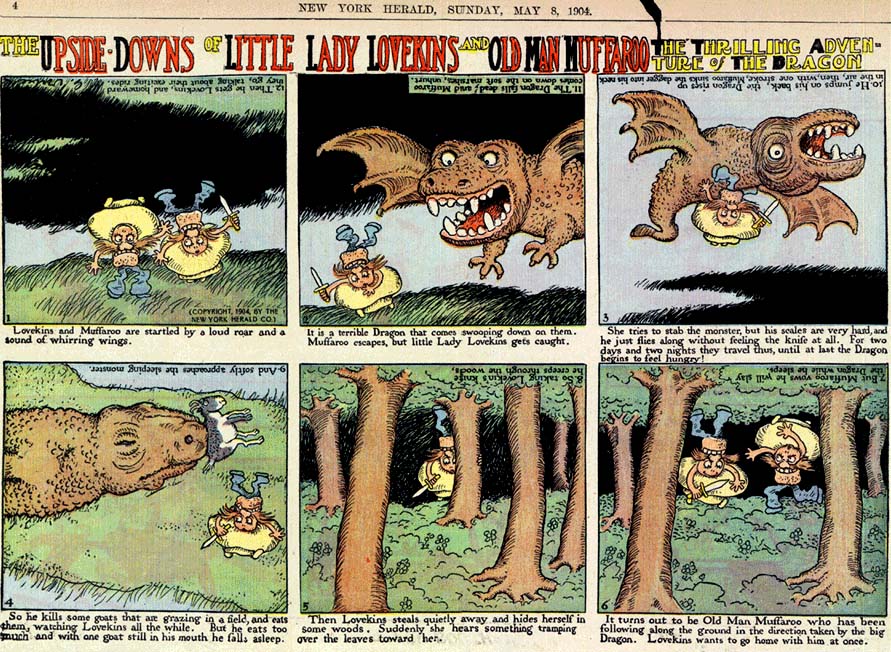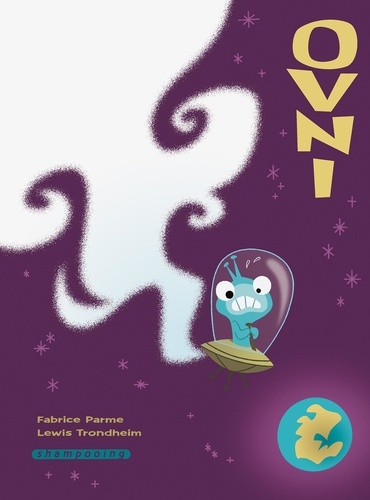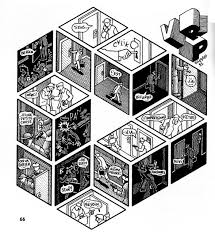Comics: 2) mathematics as the inspiration for the form rudimentary
can bring some comics of mathematical concepts. Mathematics they have consciously inspired this shape? Unconsciously?
I will quote two main authors, Marc Antoine and Etienne Lécroart Mathieu, who often grow far their formal research and find inspiration in fields near maths concepts.
We can also find some exciting things in the books of OuBaPo (workroom comic potential, little sister of the Oulipo), and draw analogies with mathematical concepts, but I do not think you can make table of Queneleiev OuBaPo with only constraints mathematics. According to the definition given to Raymond Queneau, the author Oulipian is "a rat who built himself a labyrinth which he intends to leave." There is the notion of play, experience and quasi-scientific idea that math can be creative tools or to get out of the maze. For many authors OuBaPo is essentially the game and experimentation that are the engine of creation. Sometimes mathematics is very interesting and invite themselves. Among the authors OuBaPiens is especially Etienne Lécroart which follows this view. Here are some examples: The
multi-constraint lecturabilité is often explored in literature OuBaPo. Sometimes these are strips that can be read horizontally and vertically, sometimes it's more complicated, as in the plate
ninety-five Etienne Lécroart
on a waffle iron 5 * 4, you can create a path on the chsoisissant page in the box following among neighboring right to read a new strip. As the name of this band indicates, there are 95 possibilities. It is a good exercise count
topology
The morlaque (a band that bites tail and returns to the starting point) is a classic exercise developed especially in oupus 3, here is a variant performed on a Mobius strip for the Greeting Card Association, 2008.
Symmetry Central
The palindrome letters is well known (you did too crushed, Caesar, the Hi-Port). We can say that the positions of letters, if not their shape, are symmetrical about an axis passing through the central letter or letters between the two plants). One can imagine a palindrome syllables and sentences. In comics, which can take place sentence is the box of comics.
The first box corresponds to the last second with the penultimate, and so on until the central box.
Lécroart Stephen is a veteran of the genre. Apart from two short stories appeared in Rabbit or holidays OuBaPo,
he made a 30-page comic book revolving around a machine to go back in time, where dialogue completely change the meaning if we reverse their order. A true tour de force, absolutely stunning and hilarious.
Vicious Circle Etienne Lécroart
45 ° rotation
In 3 of the oupus OuBaPo , Lécroart offers us a comic Waffle (regular square boxes) that can be read normally and then rotated 45 ° in the direction of clockwise.
The first box is at first, but after turning the board is the first box of the next line becomes the second.
Sequences and Series
Draw the line of Jean Christophe Menu and Etienne Lécroart appeared in the Oupus 1. This is an expansion of a short comic. At the first stage, there are two AA cells. to the next, is interposed between the boxes and boxes around Bababé. The third step is the same way CBCACBCACBC. An idea that can lead to enumeration of cells, the sequences and series. And also a good game that can be done with friends, writing sentences.
If the constraints it uses are often related to mathematics, it is not mandatory, but his work is interesting and exhilarating. It is best to go site and read his bands. Etienne has
Lécroart in the corner of the head and in preparation a book of comic strips based on mathematical constraints. Geometric and algebraic. I can not wait.
Marc Antoine Mathieu Antoine Mathieu Marc
is designer and cartoonist. His comic influences are to be sought among other around Schuiten and Peeters, and also Francis Masse. It is not a member of OuBaPo, although such research may be close.
Series Julius Corentin Acquefacques has many avenues of reading, it represents a world that falls somewhere between Kafka and the trial of Brazil. With a lot of housing abyss. Dreaming, the hero discovers flaws in the structure of his world or in that part of the story and seeking to redress the balance. Leaves to come face to face with the paradox and to get lost. This series is very original and some are really bluffing findings that make this comic like no other.
As a cartoon character, the hero undergoes the logic to the comic and explores the problems of his world:
In Volume 1, originally from a temporal paradox and a formal abyss, the problem of fractal is slowly but surely in play.
Volume 2 shows an obsession with measurement of space, beautiful architecture, but focuses less on the mathematical concept.
Volume 3, the process is based on the spiral .
Volume 4, the beginning of the end, is based on axial symmetry, it is undoubtedly the strangest in the series.
Volume 5, the same dimension is 2.333 based on the rules of perspective , turned upside down when a vanishing point is lost.
Moreover, Marc Antoine Mathieu has written other great comics, but without the heart of mathematics. However, in the magazine Bang! No. 4 it we propose patterns of two cubes to mount, where you can see characters trying to escape from a maze of stairs, which may suggest an interpretation of the 3-D etching Escher, "Relativity".
Other bands involving the mathematical probabilities
Cocktail Anne Baraou and Sardon (association)
unordered three dice to make a strip at random .
topology
The Möbius strip appears to numerous times to depict a journey without end or a strange world. We saw an example above. Others include:
Promethea Alan Moore and JH Williams III
180 ° rotation
Between 1903 and 1904, while the comic is in its infancy, Gustave Verbeek creates a very special sixty pages. His upside downs that chronicle the adventures of two characters, Lady and the old Mufaroo Lovekin, contain 6 images are read from left to right and top to bottom, as usual, but we see that the story is not over.
For the sequel, we shall return to the board. The rotation reverses the order of thumbnails: The sixth is the seventh, the first becomes the last. Flipped images often have a different meaning. This principle will be taken over by OuBaPo in the oupus 3.
spherical geometry
The geometry of the obsession Mazzucchelli
In this short book published in 1997, there are already many problems developed more ample in Asteryos Polyp, Special Jury Prize at Angouleme this year, among them that of the Cartesian intellectual who is struggling to return to the world of feelings. A cartographer who strives to reproduce exactly a globe and has trouble understanding that love does not check the rules is not the solution of an equation.
I would be remiss not to mention Lewis Trondheim, whose research forms sometimes leads on tracks mathematics, as in UFO (with Fabrice Parme), which resembles a gigantic probability tree , sometimes exploring Killoffer Geometries Escher .
I probably forgot. I heard such talk of comics inspired by the theory of sets and Venn diagrams .
OuBaPo The books are very stimulating and open doors:
















0 comments:
Post a Comment